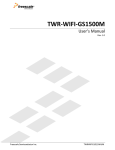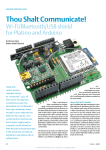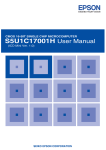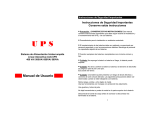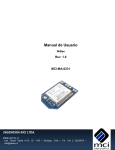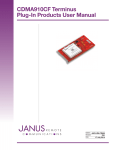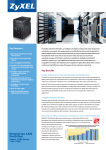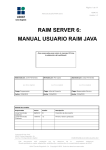Download WiFi1500CF User Manual - Janus Remote Communications
Transcript
WiFi1500CF Terminus Plug-In Product User Manual Bulletin Revision Date JA03-UM-WiFi P00 13 March 2014 TABLE OF CONTENTS TABLE OF CONTENTS and DISCLAIMER.............................................................................................................................. 2 1 Scope .............................................................................................................................................................................. 3 2 WiFi1500CF Overview....................................................................................................................................................... 3-6 2.1 Absolute Maximum Ratings...................................................................................................................................... 3 2.2 Recommended Operating Conditions...................................................................................................................... 3 2.3 Plug-In Pin-Out......................................................................................................................................................... 4 2.4 Power Connections................................................................................................................................................... 5 2.5 Screw Mount............................................................................................................................................................. 6 3 Wi-Fi Module................................................................................................................................................................... 7-10 3.1 Wi-Fi Module Connections....................................................................................................................................... 7 3.2 Wi-Fi Module Operations....................................................................................................................................... 8-9 3.3 Wi-Fi Module Firmware.......................................................................................................................................... 10 4 GPS Module (Optional)................................................................................................................................................. 11-12 4.1 GPS Module Connections...................................................................................................................................... 11 4.2 GPS Module Operation.......................................................................................................................................... 12 5 Configuration Options................................................................................................................................................... 13-14 6 Specifications..................................................................................................................................................................... 15 7 Ordering Information.......................................................................................................................................................... 16 8 Applicable Documents...................................................................................................................................................... 16 9 Revision History................................................................................................................................................................. 16 DISCLAIMER The information contained in this document is the proprietary information of Connor-Winfield Corporation and its affiliates (Janus Remote Communication). The contents are confidential and any disclosure to persons other than the officers, employees, agents or subcontractors of the owner or licensee of this document, without the prior written consent of Connor-Winfield, is strictly prohibited. Connor-Winfield makes every effort to ensure the quality of the information it makes available. Notwithstanding the foregoing, Connor-Winfield does not make any warranty as to the information contained herein, and does not accept any liability for any injury, loss or damage of any kind incurred by use of or reliance upon the information. Connor-Winfield disclaims any and all responsibility for the application of the devices characterized in this document, and notes that the application of the device must comply with the safety standards of the applicable country, and where applicable, with the relevant wiring rules. ConnorWinfield reserves the right to make modifications, additions and deletions to this document due to typographical errors, inaccurate information, or improvements to programs and/or equipment at any time and without notice. Such changes will, nevertheless be incorporated into new editions of this application note. All rights reserved 2014 Connor-Winfield Corporation WiFi1500CF Plug-In Hardware User Guide JA03-UM-WiFi Page 2 Rev: P00 Date: 03/13/14 © Copyright 2014 Janus Remote Communications Specifications subject to change without notice All Rights Reserved See website for latest revision. Not intended for life support applications. 1. Scope: This document provides a detailed hardware interface description and some general operating instructions for the WiFi1500CF. It does not cover the detailed operating instructions of the individual WiFi (GS1500M) or GPS (JN3) modules. Please refer to the documentation listed in the Applicable Documents section for further information concerning operation of these modules. 2. WiFi1500CF Overview The WiFi1500CF provides Wi-Fi connectivity and an optional GPS receiver in a footprint compatible with the Janus line of Terminus Plug-In products. A GainSpan GS1500M module provides WiFi 802.11 b/g/n radio features and comes with S2W (Serial-to-Wi-Fi) application firmware. The GS1500M is easily configured via an AT type command set over a UART interface, and support for a SPI interface is available through an optional firmware load. A Telit JN3 GPS receiver is available as an option and provides a standard NMEA UART interface and 1PPS output for tracking solutions and precision timing requirements. The power supply and I/O signals are compatible with Janus Terminus Plug-In host products such as the T2 and 400AP, or the WiFi1500CF can be used in a custom based solution. The WiFi1500 was specifically designed to provide customers with a cost effective product that is easily integrated into new and existing designs. It is completely interchangeable with other Terminus Plug-In products to allow for maximum network flexibility while removing the worry of product obsolescence. 2.1 Absolute Maximum Ratings: Parameter Min Operating Temperature -40 Storage Temperature -40 SUPPLY (input) GPS antenna bias (output) Typ Max Unit - - - - +85 +85 6.0 TBD °C °C volts mA Typ Max Unit Note 2.2 Recommended Operating Conditions: Parameter Min Operating Temperature -40 - +85 Storage Temperature -40 - +85 SUPPLY (input) 4.75 .0 5.25 SUPPLY (input) [w/ GPS] TBD SUPPLY (input) [w/o GPS] TBD PWRMON/VAUX (output; @ 2.8V) 100 TBD PWRMON/VAUX (output; @ 3.3V) 200 TBD GPS antenna bias (output) 3.3 Note °C °C volts mA WiFi1500CF v1.0 mA WiFi1500CF v2.0 mAdefault configuration mAoptional configuration volts WiFi1500CF Plug-In Hardware User Guide JA03-UM-WiFi Page 3 Rev: P00 Date: 03/13/14 © Copyright 2014 Janus Remote Communications Specifications subject to change without notice All Rights Reserved See website for latest revision. Not intended for life support applications. 2. WiFi1500CF Overview continued WiFi1500CF VIO VAUX VIO POWER GS1500M WiFi MODULE LEVEL TRANSLATORS UART0 UART I/O SPI SPI I/O RF WiFi ANTENNA CONNECTOR RF GPS ANTENNA CONNECTOR GPIO GPIO10,31 UART1 ANALOG I/O I2C SERVICE PROGRAM RESET RESET VIO POWER GPIO30 JN3 GPS MODULE LEVEL TRANSLATORS UART I/O UART 1PPS 1PPS SUPPLY WiFi POWER ENABLE VIO POWER GPS POWER DISABLE Components not populated on WiFi1500CF v2.0 (without GPS) Figure 1. WiFi1500CF Block Diagram Figure 1 WiFi1500CF Block Diagram WiFi1500CF Plug-In Hardware User Guide JA03-UM-WiFi Page 4 Rev: P00 Date: 03/13/14 © Copyright 2014 Janus Remote Communications Specifications subject to change without notice All Rights Reserved See website for latest revision. Not intended for life support applications. 2. WiFi1500CF Overview continued 2.3 Plug-In Pin-Out Pin 1 2 3 4 5 6 7 8 9 10 11 12 13 14 15 16 17 18 19 20 21 22 23 24 25 26 27 28 29 30 31 32 33 34 35 36 37 38 39 40 41 42 43 44 45 46 47 48 49 Name SUPPLY SUPPLY DISABLE WiFi RXD N/C CTS N/C 1PPS TXD N/C RTS GROUND UART1_TX UART1_RX GPIO30 GPIO31 SERVICE PWRMON N/C RESET N/C N/C N/C N/C GROUND GROUND N/C N/C N/C N/C I2C_SDA I2C_SCL GPS_RX GPS_TX N/C ASYNC GPIO10 SPI_WAKE GROUND SPI_MISO SPI_MOSI SPI_CS SPI_CLK ADC1 ADC2 ADC1 N/C VAUX GROUND Description 5.0 +/- 0.5 V Positive Supply Input 5.0 +/- 0.5 V Positive Supply Input Disable WiFi Supply GS1500M UART0_TX No Connection GS1500M UART_RTS No Connection GPS 1PPS output GS1500M UART0_RX No Connection GS1500M UART0_CTS Supply Reference GS1500M UART1_RX GS1500M UART1_TX GS1500M GPIO30 GS1500M GPIO31 Enable Firmware Load Reference Voltage No Connection Reset Cellular Radio No Connection No Connection No Connection No Connection Supply Reference Supply Reference No Connection No Connection No Connection No Connection GS1500M 12C Data GS1500M 12C Clock GPS UART - RX GPS UART – TX No Connection GS1500M GPIO19-ASYNC GS1500M GPIO10 GS1500M SPI_WAKE Supply Reference GS1500M SPI_DOUT GS1500M SPI_DIN GS1500M SPI_CS GS1500M SPI_CLK GS1500M A/D Converter 1 GS1500M A/D Converter 2 GS1500M A/D Converter 1 No Connection Reference Voltage Supply Reference NOTES: N/A – not applicable VIO – I/O logic level. VIO is 2.8V by default; can be configured to 3.3V by changing 0 ohm jumpers on the board. 1. SUPPLY pins are internally connected. 2. Disable input for WiFi supply (independent of GPS supply). Pin is internally pulled up to SUPPLY voltage and can be left floating for alwayson operation. For shutdown, pull low with open collector/drain driver. 3. The GS1500M UART interfaces are cross connected to appear as a DCE devices on the WiFi1500CF pinout. 4. N/C (no connection). The pin has no function and makes no electrical connection. I/O Signal Power Input Power Input CMOS Input CMOS Output N/A CMOS Output N/A CMOS Output CMOS Input N/A CMOS Input Power CMOS Input CMOS Output CMOS Bi-Direction CMOS Bi-Direction TTL Input Analog Output N/A CMOS Input N/A N/A N/A N/A Power Power N/A N/A N/A N/A CMOS Bi-Direction CMOS Bi-Direction CMOS Input CMOS Output N/A CMOS Output CMOS Bi-Direction CMOS Output Power CMOS Output CMOS Input CMOS Input CMOS Input Analog Output Analog Input Analog Input N/A Analog Output Power I/O Level N/A N/A SUPPLY VIO N/A VIO N/A VIO VIO N/A VIO N/A VIO VIO VIO VIO VIO N/A N/A N/A N/A N/A N/A N/A N/A N/A N/A N/A N/A N/A N/A N/A VIO VIO N/A VIO VIO VIO N/A VIO VIO VIO VIO N/A N/A N/A N/A N/A N/A Pull Type N/A N/A PULL-UP to SUPPLY N/A N/A N/A N/A N/A N/A N/A N/A N/A N/A N/A N/A N/A PULL-UP to VIO N/A N/A PULL-UP to 3.3V N/A N/A N/A N/A N/A N/A N/A N/A N/A N/A N/A N/A N/A N/A N/A N/A N/A N/A N/A N/A N/A N/A N/A N/A N/A N/A N/A N/A N/A Notes 1 1 2 3 4 3 4 5,9 3 4 3 6,9 6,9 9 7 4 8 4 4 4 4 4 4 4 4 5,6 5,6 9 9 4 5,6 5,6 5,6 4 - 5. Must be enabled by installing 0 ohm jumpers on the board. See Configuration Options section. 6. Not supported in standard firmware 7. Enable input for loading GS1500 firmware. Pin is internally pulled up to VIO voltage and can be left floating. For enabling firmware load, pull low with open collector/drain driver. (There is also provision for a jumper for this on the board.). 8. Connected to GS1500 RESET pin and a 22K pullup resistor to 3.3 V through a 1 k series resistor. 9. Only available on WiFi1500CF V1.0 boards (with GPS). Pin is N/C (no connection) on WIFi1500CF V2.0 boards. WiFi1500CF Plug-In Hardware User Guide JA03-UM-WiFi Page 5 Rev: P00 Date: 03/13/14 © Copyright 2014 Janus Remote Communications Specifications subject to change without notice All Rights Reserved See website for latest revision. Not intended for life support applications. 2. WiFi1500CF Overview continued 2.4 Power Connections SUPPLY – 5.0 volt supply for the module (referenced to the GROUND pins). The two SUPPLY pins (pins 1 and 2) are internally connected together. PWRMON / VAUX – These pins are connected to the internal VIO supply that powers the level shifters used on several of the I/O pins. The two pins are internally connected; the different names are used to maintain compatibility with other Terminus Plug-In products. This voltage can be used as a reference for an external interface. The VIO supply can be connected to an internal 2.8 volt supply or an internal 3.3 volt supply. The default is the 2.8 volt supply so as to be compatible with the Terminus Plug-In host products (e.g T2, 400AP). See the Configuration Options section for information on changing the VIO supply. The following I/O pins use the level shifters or are associated with the VIO supplies: Pin Name 4 6 8 9 11 13 14 15 16 17 RXD 34GPS_RX1 CTS 35GPS_TX1 1 1PPS 36ASYNC TXD 37GPIO10 RTS 38SPI_WAKE UART1_TX 40SPI_MISO UART1_RX 41SPI_MOSI GPIO301 42SPI_CS GPIO31 43SPI_CLK SERVICE2 PinName 1. These pins are not connected on the WiFi1500CF v2.0 (w/o GPS) 2. This pin uses a discrete transistor implementation for a level shifter. ENABLE – Used to disable the GS1500M and level shifter power supplies. This pin is internally pulled up to the SUPPLY voltage which enables the power supplies by default. Pulling this pin low will disable the internal GS1500M and level shifter power supplies. The GPS supply is unaffected. This can allow for reduced power consumption by disabling the GS1500M WiFi module while allowing the GPS receiver to continue to operate. 2.5 Screw Mounting The WiFi1500CF allows for the use of a #4 machine screw to help keep a socketed module in place where environmental variables may cause problems otherwise. If the user wishes to have a stand-off underneath the module to help alleviate possible stress from mounting hardware, below are the Janus part numbers and associated drawings for an available solution. 4-40 Hex Female Stand-off: MC-0356-G 4-40 3/16” Pan Head Phillips Machine Screw: MC-0357-G Figure 2. Screw Diagram WiFi1500CF Plug-In Hardware User Guide JA03-UM-WiFi Page 6 Rev: P00 Date: 03/13/14 © Copyright 2014 Janus Remote Communications Specifications subject to change without notice All Rights Reserved See website for latest revision. Not intended for life support applications. 3. WiFi Module The GainSpan GS1500M provides the WiFI connectivity for the WiFi1500CF. A complete description of this module is beyond the scope of this document. Detailed hardware and operational information can be found in the GS1500M documentation listed in the Applicable Documents section. 3.1 WiFi Module Connections The connections between the GS1500M module and the WiFi1500CF pins are shown in the table below. GS1500M Pin Name Interface WiFi1500CF Pin Name 1 GND GND 2 JTAG_TCLK N/C 3 JTAG_TDO N/C 4 JTAG_TDI N/C 5 JTAG_TMS N/C 6 JTAG_nTRST N/C 7 ALARM1 N/C 8 RTC_OUT1 N/C 9 VBAT 3.3V 10 DC_DC_CNTL N/C 11 ADC1 --- 44,461 ADC1 12 ADC2 --- 451 ADC2 13 ALARM2 N/C 14 MSPI_DIN N/C 15 MSPI_DOUT N/C 16 VOUT_1V8 Internal2 17 GND GND 18 MSPI_CLK N/C 19 MSPI_CS0 N/C 20 MSPI_CS1 N/C 21 GPIO21 N/C 22 GPIO20 N/C 23 GPIO19 Level Shifter 36 ASYNC 24 GPIO10 Level Shifter 37 GPIO10 GS1500M Pin Name Interface 25 26 27 28 29 30 31 32 33 34 35 36 37 38 39 40 41 42 43 44 45 46 47 48 -- I2C_CLK I2C_DATA SSPI_DOUT SSPI_CLK SSPI_CS SSPI_DIN VIN_3V3 GND EN_1V8 VDDIO UART1_CTS UART1_RTS UART1_RX UART1_TX UART0_TX UART0_RTS UART0_RX UART0_CTS GPIO31 GPIO30 GPIO29 GPIO28 EXT_RSTn GND Antenna WiFi1500CF Pin Name Pullup to VIO 321 Pullup to VIO 311 Level Shifter 44 Level Shifter 43 Level Shifter 42 Level Shifter 41 3.3V GND 3.3V 3.3V N/C Pullup to VIO 17 Level Shifter 13 Level Shifter 14 Level Shifter 4 Level Shifter 6 Level Shifter 9 Level Shifter 11 Level Shifter 16 Level Shifter 15 N/C Level Shifter 38 Pullup to 3.3V 20 GND u.FL connector I2C_SCL I2C_SDA SPI_MISO SPI_CLK SPI_CS SPI_MOSI SERVICE UART1_TX UART1_RX RXD CTS TXD RTS GPIO31 GPIO30 SPI_WAKE RESET 1 Jumpers must be installed to connect these pins. See the Configuration Option section. 2 The GS1500M VOUT_1V8 pin can be jumpered to the JN3 module’s BOOT pin. See the Configuration Option section. Antenna The GS1500M has an on-board PCB (printed circuit board) antenna and a u.FL RF connector to support an external WiFi antenna. The u.FL connector is located on the edge of the GS1500M module board that overhangs the WiFi1500CF board. Commands entered via the GS1500’s UART or SPI port can be used to select which antenna is used. UART interface UART0 on the GS1500M is brought out through a level shifter and support is provided for TX, RX, CTS and RTS signals. While the GS1500 has DTE (Data Terminal Equipment) UART configuration, an internal crossover network converts this to appear as a DCE (Data Communications Equipment) device on the pin-out of the WiFi1500CF. This makes it compatible with host processors (e.g. Janus 400AP, T2) and other microcontroller devices that typically present a DTE UART interface. The default settings for the UART0 interface are 9600 baud, 8 bit characters with no parity bits and one stop bit (8N1). ASYNC Connected to the GS1500M GPIO19 pin through a level shifter. When enabled via the command interface, this pin can be used to provide notification of asynchronous messages at the UART0 port. (See ‘Enhanced Asynchronous Notification’ in the GS1500M Serial-to-WiFi Adapter Application Programming Guide.) SPI interface The GS1500M SPI slave port is brought out through a level shifter and support is provided for the SPI_MISO, SPI_MOSI, SPI_CS, SPI_CLK and the SPI_WAKE pins. The SPI port provided as an alternative to the UART0 interface on the GS1500M, and can provide faster communication speeds (up to 3 Mbps) than the UART0 interface. SPI_WAKE Connected to the GS1500M GPIO28 pin through a level shifter. This pin is asserted high during data transmission periods. It notifies the host (SPI master) that it can begin receiving data by providing the SPI clock signal. In addition, it provides an indication that the SPI interface is operational following start up. (See ‘SPI Interface Handling‘ and ‘Node Start Up Handling’ in the GS1500M Serial-to-WiFi Adapter Application Programming Guide.) WiFi1500CF Plug-In Hardware User Guide JA03-UM-WiFi Page 7 Rev: P00 Date: 03/13/14 © Copyright 2014 Janus Remote Communications Specifications subject to change without notice All Rights Reserved See website for latest revision. Not intended for life support applications. 3. WiFi Module Continued 3.2 WiFi Module Operations Operation of the GS1500M WiFi module requires a serial connection to the device, either through its UART0 port or its slave SPI port. (The SPI Mode 0 firmware load is required to support the SPI port connection.) Operational commands and data strings are transferred using the serial connection. A complete description is beyond the scope of this User Manual; please refer to the GS1500M Serial-to-WiFi Adapter Application Programming Guide. The GS1500M can operate in 3 different modes that are related to how the serial interface is utilized: Command mode (default) – Command strings using an ‘AT’ command format can be used to configure the module. Data processing mode – Using escape character sequences, data can be sent and received from up to 16 different IP address-port locations. Auto connect mode – The module can be pre-configured to connect to a network at start-up as either a TCP or UDP client or server. Following start-up, serial data is automatically sent to and received from a remote IP address via the selected protocol. 3.2.1 Set-up: This section describes the minimum hardware set-up requirements and some basic command procedures to operate the GS1500M module. 3.2.1.1 Hardware Set-up Hardware set-up requires the following: - UART connection (GS1500M UART0). At a minimum the TX and RX lines must be supported. The WiFi1500CF interface pins are at VIO voltage levels; the default value is 2.8 volts. The default UART configuration is 9600 baud, 8 bits, no parity, 1 stop bit (8N1). - Antenna selection. The GS1500M has a printed circuit antenna that is selected by default. Alternatively, an external WiFi antenna may be connected to the u.FL connector on the GS1500M module board. In this case the U.FL connector antenna must be selected via a AT command; see the Basic Configuration section below. - Power. Apply power to the unit by providing 5.0 +/- 0.25 volts across the WiFi1500CF SUPPLY and GND pins. 3.2.1.2 Basic Commands: In general, the AT commands are insensitive to character case. Successful commands usually return the characters “OK” (if the default verbose mode is enabled). Please refer to the GS1500M Serial-to-WiFi Adapter Application Programming Guide for details. Those commands requiring user parameters are indicated with the parameter being given in inequality brackets, e.g. <PARAMETER>. Below are a few basic commands that can be used to demonstrate serial connectivity with the GS1500M: AT+NSTAT=? AT+WS WT+NMAC=? Network Status query Scan for WiFi networks MAC address query The following disassociate command should be used before proceeding with any of the operational examples given in the sections below to insure that any previous operating mode is cleared: AT+WD Disassociate AT&F Restore to factory defaults A reset to factory default conditions can be achieved with the following command: 3.2.1.3 Basic Configuration: When first powered, the GS1500M module will initialize and then send “Serial2WiFi APP” to the UART port, whereupon the module is ready to receive commands. (If the module has been configures to auto connect, a network status message is sent instead.) The antenna output should be set to the printed circuit board antenna or the external antenna connected to the u.FL connector. The antenna selection command is: AT+ANTENNA=<n> Where <n> specifies whether the printed circuit board antenna or the external u.FL antenna is selected: 1 = printed circuit board antenna 2 = u.FL connector WiFi1500CF Plug-In Hardware User Guide JA03-UM-WiFi Page 8 Rev: P00 Date: 03/13/14 © Copyright 2014 Janus Remote Communications Specifications subject to change without notice All Rights Reserved See website for latest revision. Not intended for life support applications. 3. WiFi Module Continued 3.2 WiFi Module Operations continued 3.2.2 Operation examples Below are several examples of configuring the GS1500M module. The UDP Client example configures the module to connect to an existing infrastructure WiFi network using command mode, then sends UDP data to a server using data mode. The Web Provisioning example is a command mode sequence of instructions that initiates the module’s provisioning web server. The Auto Connect example configures the unit to automatically connect as a TCP server to a specific client. Upon restart in the Auto Connect mode a connection is made between the client and server, at which point data can be transparently passed back and forth between them. These examples assume that the GS1500M WiFi module begins configured in its default state, and that no encryption is used. 3.2.2.1 UDP Client Issuing the following sequence of commands will set up the GS1500M module as a station in an existing infrastructure WiFi network: AT+WM=0 Mode (0=infrastructure). AT+NDHCP=1 DHCP (1=enable). AT+WA=<SSID> Associate with a WiFi network having designated SSID. AT+NCUDP=<Dest-Address>,<Port> Returns: CONNECT <CID> Setup UDP Client. Successful Command will return a Connection Identifier number. At this point UDP data can be sent to a server (at <Dest-address>, <port>) with the following command: <Esc>S<CID><data><Esc>E Send UDP data. 3.2.2.2 Web Provisioning The web provisioning feature included in the default firmware load allows the GS1500M to host a few simple web pages that allow for provisioning of the module. It can be set by issuing the following commands: AT+NSET=<IP>,<SUBNET MASK>,<GATEWAY IP> Static Configuration. AT+WM=2 Mode (2=limited Access Point). AT+WA=<SSID>,,<CHANNEL> Start AP network using SSID on designated CHANNEL. AT+DHCPSRVR=1 DHCP server (1=enable). AT+WEBPROV=<USERNAME>,<PASSWORD> Start web provisioning. The USERNAME and PASSWORD will be required to login. At this point a client can connect to the GS1500M module at it’s <IP> address. The GS1500M will request the <USERNAME> and <PASSWORD> to be entered. This gives access to web pages hosted on the module that allow for provisioning of the GS1500M. WiFi1500CF Plug-In Hardware User Guide JA03-UM-WiFi Page 9 Rev: P00 Date: 03/13/14 © Copyright 2014 Janus Remote Communications Specifications subject to change without notice All Rights Reserved See website for latest revision. Not intended for life support applications. 3. WiFi Module Continued 3.2 WiFi Module Operations continued 3.2.2 Operation examples 3.2.2.3 Auto Connect In the example below, the GS1500M module is configured to connect to an access point, the auto connect feature is enabled, and the settings are stored in a profile. When re-started, the unit will connect to the access point whereupon serial data can be transferred to and from a remote IP address. AT+NDHCP=1 DHCP enable AT+WAUTO=0,<SSID> Set auto wireless parameters (0=infrastructure). AT+NAUTO=1,1,<Destination IP>,<Port> Set auto network parameters (TCP server). ATC1 Set the auto connect mode AT&W0 Save the configuration in profile 0 AT&Y0 Set to load profile 0 at start-up At this point the GS1500M module should be restarted, either by pulling the RESET pin (WiFi1500CF pin 47) low or by removing and re-establishing power to the unit. The GS1500M will respond with its network settings upon successfully associating with the wireless network. Serial data can now be sent to and from the GS1500 via the serial port. A telnet session or a simple TCP terminal can be opened at the client (destination IP) to demonstrate the sending and receiving of serial data. In order to terminate the Auto Connect session, enter a sequence of three ‘+’ (plus) symbols followed by one second of no data being entered. Following this the command mode will be available. 3.3 WiFi Module Firmware The GS1500M WiFi module can be loaded with several versions of the S2W (Serial-to-WiFi) application firmware. Because of limited memory, certain features are only exclusively available in specific firmware loads. By default, the module is loaded with the Web Provisioning firmware. The table below illustrates the features available on the available firmware loads: Firmware Enterprise Security (EAP) SPI Mode 0 Web Server Provisioning Wi-Fi Protected Setup (WPS) RF Test Notes Enables SPI interface DEFAULT Contact Janus about providing the WiFi1500CF with firmware loads other than the default Web Server Provisioning version. WiFi1500CF Plug-In Hardware User Guide JA03-UM-WiFi Page 10 Rev: P00 Date: 03/13/14 © Copyright 2014 Janus Remote Communications Specifications subject to change without notice All Rights Reserved See website for latest revision. Not intended for life support applications. 4. GPS Module (Optional) The Telit JN3 GPS receiver provides position and timing information using standard NMEA (National Marine Electronics Association) strings over a UART interface. In addition, a 1PPS signal is available to provide an accurate timing mark when a high quality fix is available. A complete description of this module is beyond the scope of this document. Detailed hardware and operational information can be found in the JN3 GPS receiver documentation listed in the Applicable Documents section. 4.1 GPS Module Connections The connections between the JN3 module and the WiFi1500CF pins are shown in the table below. JN3 Pin Name Interface 1 2 3 4 5 6 7 8 9 10 11 12 NC NC 1PPS EXT_INT NC NC BOOT NC VCC_IN GND RF_IN GND WiFi1500CF Pin Name N/C N/C Level Shifter 8 1PPS N/C N/C N/C Internal1 N/C 3.3V GND u.FL Connector GND JN3 Pin Name Interface 13 14 15 16 17 18 19 20 21 22 23 24 GND NC NC NC NC SDA2 SCL2 TX RX VBATT VCC_IN GND WiFi1500CF Pin Name GND N/C N/C N/C N/C N/C N/C Level Shifter 34 Level Shifter 33 N/C 3.3V GND GPS_X GPS_RX N/C – Not Connected 1 The GS1500M VOUT_1V8 pin can be jumpered to the JN3 module’s BOOT pin. See the Configuration Option section. Antenna A u.FL connector is provided for connecting a GPS antenna. This connector is located on the top surface of the WiFi1500CF board at the pin 25 corner. This connector also provides a 3.3 volt bias at the antenna connector for powering remote amplifiers that are often built in to GPS antennas. Do not short the antenna output UART interface The UART on the JN3 GPS module is brought out through a level shifter and support is provided for the TX and RX signals. The default setting for the JN3 GPS UART interface is 4800 baud, 8 bit characters with no parity bits and one stop bit (8N1). The JN3 GPS module provides a NMEA interface on the UART; more information can be found in the ‘JN3 Product Description’ document listed in the Applicable Documents section. 1PPS output A 1PPS (one pulse-per-second) output is available from the GPS receiver when a high quality (3D) position fix is obtained. The pulse width is 200 ms and the leading edge of the pulse is synchronous with one second timing. The 1PPS signal appears on the WiFi1500CF pin that is designated as the GS1500M UART0 DCD pin. The DCD pin is a standard 1PPS interface on serial connections to hosts running NTP (network timing protocol) applications. For a full implementation, the JN3 UART TX and RX signals should also appear on the UART0 interface. This can be accomplished by changes to the configuration jumpers. See the Configuration Options section. WiFi1500CF Plug-In Hardware User Guide JA03-UM-WiFi Page 11 Rev: P00 Date: 03/13/14 © Copyright 2014 Janus Remote Communications Specifications subject to change without notice All Rights Reserved See website for latest revision. Not intended for life support applications. 4. GPS Module (Optional) continued 4.2 WiFi Module Operation Hardware set-up requires the following: - UART connection (JN3 UART). The TX and RX lines are supported on the WIFi1500CF pins 34 (GPS_TX) and 35 (GPS_RX). These interface pins are at VIO voltage levels; the default VIO value is 2.8 volts. The default UART configuration is 9600 baud, 8 bits, no parity, 1 stop bit (8N1). - Antenna connection. The JN3 requires that a suitable external GPS antenna be connected to the u.FL connector on the WiFi1500CF board. The GPS antenna has to be located so as to allows a reasonable ‘view of the sky’ in order to receive the GPS satellite signals. - Power. Apply power to the unit by providing 5.0 +/- 0.25 volts across the WiFi1500CF SUPPLY and GND pins. Basic operation of the JN3 GPS module consists of utilizing the NMEA messages that are output by the module on the UART interface. By default, the module will output the following NMEA messages on start-up: Message Rate GGA GSA RMC GSV once per second once per second once per second once every five seconds NMEA input messages can be used to control a number of the JN3 GPS modules operational characteristics, including the UART interface parameters, the standard NMEA messages being output, and the rate at which the NMEA messages are output. See the SiRF NMEA Reference Manual for additional information. Below is a complete list of the available NMEA messages: Message Description GGA GLL GSA GSV RMC VTG ZDA GPS Fixed Data Geographic Position – Latitude/Longitude GNSS DOP and Active Satellites GNSS Satellites in View Recommended Minimum Data Course Over Ground and Ground Speed 1PPS Timing Message In addition to the NMEA messages, the JN3 module supports the SiRF One Socket Protocol (OSP) protocol. Please refer to the Applicable Documents section for further reference material. WiFi1500CF Plug-In Hardware User Guide JA03-UM-WiFi Page 12 Rev: P00 Date: 03/13/14 © Copyright 2014 Janus Remote Communications Specifications subject to change without notice All Rights Reserved See website for latest revision. Not intended for life support applications. 5. Configuration Options Notes 5. Configuration Options Interface Voltage* R22 2.8 volts (default) 3.3 volts 0 ohm OMIT T2 & 400AP OMIT 0 ohm user interface R23 USAGE * Interface voltage: VIO affects the following CF terminals: GS1500M Flash programming J2F GPS Flash programming JP2 installed GS1500 SPI INTERFACE CF PIN FUNCTION I2C SCL I2C SDA disabled (default) enabled CELL LED GPS TX+ GPS LED GPS RX+ TRACE RX TRACE TX GS1500 ADC/DAC INTERFACE CF PIN FUNCTION INSTALL ADC1 ADC2 DAC R3 R4 R5 GS ADC1/DAC GS ADC2 GS ADC1/DAC GPIO7 ASYNC R1 GS1500 drives ASYNC high during asynchronous serial output. GPS POWER SUPPLY BYPASS Dedicated GPS low noise supply can be omitted by: Installing: FB5 Removing: U8 FB4 R29,R30 C18,C19,C20,C21 USAGE I2C CLK install R9 to enable I2C DATA install R10 to enable optional pull-up resistors: I2C CLK - R21 I2C DATA - R20 J2F GPS I2C INTERFACE R9 UART TX UART RX UART RTS UART CTS GS1500 SERIAL ASYNC CF PIN FUNCTION INSTALL SPI CLK SPI CS SPI MOSI SPIMISO SPI WAKEUP GS1500 I2C INTERFACE CF PIN FUNCTION GPIO5 GPIO6 GPIO7 UART DCD + GPS RX/TX can be configured to bypass level shifters for use with the 400AP. CF SERVICE pin 17 pulled low -- or -JP1 installed GPIO1 GPIO2 GPIO3 GPIO4 GPIO5 GPIO1 GPIO2 GPIO3 GPIO4 GS1500 STANDBY MODE Not supported. Allows placing GS1500 module into a low power mode for a set time period. R10 OMIT OMITt 0 ohm 0 ohm UART TX/RX INTERFACE WIFI GPS R14 R15 R16 R19 R8 R13 R6 R7 R12 UART0 TX/RX @VIO GPS TX/RX @VIO 0 ohm 0 ohm OMIT OMIT OMIT OMIT 0 ohm 0 ohm OMIT (default) UART0 TX/RX @VIO GPS TX/RX @3.3V OMIT OMIT 0 ohm 0 ohm OMIT OMIT 0 ohm 0 ohm OMIT disabled UART0 TX/RX @VIO OMIT OMIT OMIT OMIT 0 ohm 0 ohm OMIT OMIT 0 ohm WiFi1500CF Plug-In Hardware User Guide JA03-UM-WiFi Page 13 USAGE T2 w [email protected] 400AP w [email protected] GPS w/ PPS on DCD Rev: P00 Date: 03/13/14 © Copyright 2014 Janus Remote Communications Specifications subject to change without notice All Rights Reserved See website for latest revision. Not intended for life support applications. 5. Configuration Options continued Figure 3. Top Components Figure 4. Bottom Components WiFi1500CF Plug-In Hardware User Guide JA03-UM-WiFi Page 14 Rev: P00 Date: 03/13/14 © Copyright 2014 Janus Remote Communications Specifications subject to change without notice All Rights Reserved See website for latest revision. Not intended for life support applications. 6. Specifications General: Dimensions: 2.75” x 1.4” x 0.475” Operational temperature range: -40°C to 85°C RoHS compliant WiFi Radio: 802.11b/g/n compliant Security Protocols: - WEP - 802.11i WPA/WPA2 Personal Security (AES and TKIP) - Enterprise Security (EAP-FAST, EAP-TLS, EAP-TTLS, PEAP) Networking Protocols: - UDP, TCP/IP (IPv4) - DHCP, ARP, DNS, SSL, HTTP/HTTPS Client and Server Interface: - UART to 921.6kbps - SPI up to 3Mbps FCC Certified CE Compliant GPS Receiver (optional): L1 band 48 channel receiver NMEA data, PPS output Time to First Fix (90% @ -130 dBm): - 1s Hot Start - <35s Cold Start Sensitivity: - Acquisition: -147 dBm - Navigation: -160 dBm - Tracking: -163 dBm Dedicated GPS antenna connection with active antenna WiFi1500CF Plug-In Hardware User Guide JA03-UM-WiFi Page 15 Rev: P00 Date: 03/13/14 © Copyright 2014 Janus Remote Communications Specifications subject to change without notice All Rights Reserved See website for latest revision. Not intended for life support applications. WiFi1500CF Terminus Plug-In Product User Manual 7. Ordering Information Model WiFi1500CF v1.0 WiFi1500CF v2.0 DESCRIPTION Terminus WiFi Plug-In Modem – GPS enabled Terminus WiFi Plug-In Modem – without GPS 8. Applicable Documents Terminus Plug-In Products: Terminus T2 Products User Manual – Hardware Guide Terminus 400AP Products User Manual – Hardware Guide GainSpan GS1500M WiFi module: GS1500M Data Sheet Serial-to-WiFi Adapter Application Programming Guide Serial-to-WiFi Adapter Command Reference AN-025 Serial to WiFi Bridge AN-039 Provisioning Methods with S2W AN-045 S2W UDP, TCP, HTTP Connection Management Examples Telit JN3 GPS Receiver: JN3 Product Description JN3 Hardware User Guide SiRF NMEA Reference Manual SiRFstarIV™ One Socket Protocol Interface Control Document One Socket Protocol Interface Control Document Including SiRF Binary Protocol Reference Manual Revision History Revision Revision Date Note P00 Preliminary WiFi1500CF Plug-In User Manual 03/13/2014 Division of The Connor-Winfield Corporation 2111 Comprehensive Drive • Aurora, Illinois 60505 630.499.2121 • Fax: 630.851.5040 www.janus-rc.com Janus Remote Communications Europe Bay 143 Shannon Industrial Estate Shannon, Co. Clare, Ireland Phone: +353 61 475 666



















